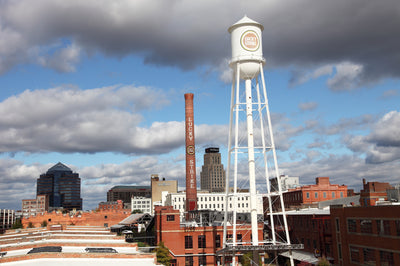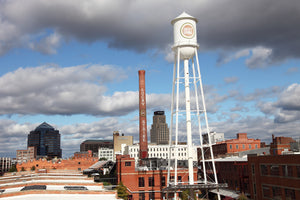Emma Schultz, M.S. | Scientific Contributor
**Updated July 5, 2021 to include current data
For our assessment of Norfolk's tap water quality, our Water Nerds aggregated the most recent water quality test data from the City of Norfolk Department of Utilities, the U.S. Environmental Protection Agency (EPA), as well as from samples that we collect and analyze. Our team cross references these data with toxicity studies in scientific and medical literature, and look at upcoming regulatory changes. The water filters that we sell in Norfolk are optimized with these data in mind.
Source Of Norfolk Drinking Water
Norfolk’s drinking and tap water is a mixture of surface and groundwater. Water comes from eight reservoirs, with two in Norfolk proper, three in Virginia Beach, two in Suffolk, and one in Isle of Wight. Water also comes from the Blackwater and Nottoway Rivers, and four deep wells in Isle of Wight County. The City of Norfolk Department of Utilities operates two water treatment plants, the 37th Street Treatment Plant and the Moores Bridges Treatment Plant, where water is treated and filtered before being delivered to customers.
Per and Polyfluoroalkyl Substances (PFAS) In Norfolk Drinking Water
PFAS are a class of chemicals found various non-stick, stain resistent products, as well as fire fighting foam. PFAS are considered to be "emerging contaminants" because they are not currently regulated by EPA, but are known to be toxic and persistent in the environment. PFAS have historically been an ingredient in fire fighting foam, which is why they're often found on or near military bases. Norfolk detected PFAS levels between 73-3,373 parts per trillion, which are upwards of 169 times higher than advisory levels. Hydroviv undersink filters remove PFAS. If you'd like to check out third-party data on our removal rates, send us an email at hello@hydroviv.com.
Lead In Norfolk Drinking Water
Lead enters Norfolk consumer's tap water through old lead service pipes and lead-containing plumbing. When corrosion control measures fail (such as what recently happened in Flint, Michigan), lead leaches into drinking water and can reach toxic levels. Recent analysis for lead in Norfolk's water found a 90th percentile concentration of less than 2.5 ppb. While the Action Level is 15 ppb, the EPA, CDC and American Academy of Pediatrics recognize that there is no safe level of lead for children. In addition, federal regulations cannot possibly take into account levels measured at an individual tap.
Chromium 6 In Norfolk Drinking Water
Chromium 6 is a highly toxic metal that, while monitored, is not regulated by the EPA. Norfolk’s tap water recently averaged 46 parts per trillion for chromium 6. Average levels are 2 times higher than the concentration determined to have a negligible impact on cancer risk.
Disinfection Byproducts (DBPs) In Norfolk Drinking Water
DBPs are a category of emerging contaminants that form when chlorine-based disinfectants react with naturally-occurring organic matter. Although these chemicals are not well regulated, the EPA has concluded that they are associated with an increased risk of bladder cancer, as well as kidney, liver, and central nervous system problems. EPA regulates two categories of DBPs: Total Trihalomethanes (TTHMs) and Haloacetic Acids (HAA5). The average concentration of TTHMs in Norfolk drinking water are 45 parts per billion. The average concentration of HAA5 in Norfolk drinking water is 26 parts per billion. For a bit of context, the Maximum Contaminant Level for TTHMs is 80 parts per billion, and 60 parts per billion for HAA5.
Use Of Chloramine In Norfolk Tap Water
While most cities use chlorine as the primary disinfectant, Norfolk’s water is disinfected with chloramine, which is produced by mixing chlorine and ammonia. Chloramine is primarily responsible for what many customers report as the “bad taste”of tap water, and unlike chlorine will not dissipate if a container of water is left in the fridge overnight. Most one-size-fits-all water filters use filtration media that doesn’t do a great job removing chloramine, but the filters that Hydroviv builds for Norfolk uses special filtration media that is purpose-built to remove chloramine as well.
Still Have Questions About Norfolk’s Tap Water?
Hydroviv is a water filtration company that uses water quality data to optimize water filters for each city’s water. The chemicals that we list above are what we consider to be “points of emphasis” so we can build the best water filter for Norfolk tap water, but all of our water filters provide broad protection against other contaminants commonly found in drinking water (e.g. VOCs, heavy metals [including lead], pharmaceuticals, solvents, pesticides, mercury).
If you’re interested in learning more about water filters that have been optimized for Norfolk tap water, feel free to visit www.hydroviv.com, reach out by email (hello@hydroviv.com) or through our live chat. We also frequently post water-related news on Twitter or Facebook.
Please Share This Norfolk Tap Water Quality Article On Social Media With Anyone You Think Would Benefit From The Information!
Recommended Articles For You
What Do I Need To Know About Lead Contamination And Lead Poisoning?
How To Filter Chromium 6 From Drinking Water
What Do I Need To Know About Disinfection Byproducts?
Why Does EPA Allow Toxic Chemicals In Drinking Water?





